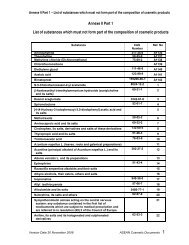Pollution from Personal Actions, Activities, and Behaviors - US ...
Pollution from Personal Actions, Activities, and Behaviors - US ...
Pollution from Personal Actions, Activities, and Behaviors - US ...
You also want an ePaper? Increase the reach of your titles
YUMPU automatically turns print PDFs into web optimized ePapers that Google loves.
<strong>Pollution</strong> <strong>from</strong> <strong>Personal</strong> <strong>Actions</strong>, <strong>Activities</strong>, <strong>and</strong> <strong>Behaviors</strong>:<br />
Pharmaceuticals <strong>and</strong> <strong>Personal</strong> Care Products in the Environment<br />
= Multidimensional Science Issues Relevant to Regulatory Considerations <<br />
Christian G. Daughton, Ph.D.<br />
Chief, Environmental Chemistry Branch, Environmental Sciences Division,<br />
National Exposure Research Laboratory, Office of Research <strong>and</strong> Development,<br />
U.S. Environmental Protection Agency, Las Vegas, NV<br />
daughton.christian@epa.gov; 702-798-2207<br />
Perhaps more so than with any other class of anthropogenic chemicals, the occurrence of pharmaceuticals<br />
<strong>and</strong> personal care products (PPCPs) in the environment highlights the immediate, intimate, <strong>and</strong><br />
inseparable connection between the personal activities of individual citizens <strong>and</strong> their environment.<br />
PPCPs, in contrast to other types of environmental contaminants, owe their origins in the environment<br />
directly to their worldwide, universal, frequent, highly dispersed, <strong>and</strong> individually small but cumulative<br />
usage by multitudes of individuals — as opposed to the larger, highly delineated, <strong>and</strong> more-controllable<br />
industrial manufacturing/usage of most high-volume synthetic chemicals.<br />
PPCPs are a diverse group of chemicals, used internally or externally with the bodies of humans <strong>and</strong><br />
domestic animals (<strong>and</strong> agricultural plants), comprising a wide spectrum of chemical classes. In very<br />
general terms, PPCPs include: < drugs (available by prescription or over-the-counter; including the new<br />
genre of “biologics”), < diagnostic agents (e.g., X-ray contrast media), < “nutraceuticals” (bioactive food<br />
supplements such as huperzine A), <strong>and</strong> < other consumer chemicals, such as fragrances (e.g., synthetic<br />
musks) <strong>and</strong> sun-screen agents (e.g., methylbenzylidene camphor); also included are < “excipients” (socalled<br />
“inert” ingredients used in PPCP manufacturing <strong>and</strong> formulation); the universe of included<br />
chemicals is exp<strong>and</strong>ed yet further by the numerous environmental transformation products (many of<br />
these “daughter” products can also be bioactive) that can be created <strong>from</strong> each parent compound. In<br />
addition to the better known antimicrobials <strong>and</strong> steroids, over 50 individual PPCPs or metabolites (<strong>from</strong><br />
more than 10 broad classes of therapeutic agents or personal care products) had been identified [as of<br />
1999; see Environ. Health Perspect. 1999, 107(suppl 6), 907-938] in environmental samples (mainly in<br />
sewage, surface, <strong>and</strong> ground waters). It is important to note that although a number of representatives<br />
<strong>from</strong> small subsets of therapeutic classes have been identified in the environment, numerous members of<br />
most classes have yet to be searched for. Many of these unreported drugs are among the most widely<br />
prescribed in the U.S.<br />
Many PPCPs (as well as their metabolites <strong>and</strong> transformation products) can enter the environment<br />
following ingestion or application by the user or administration to domestic animals. Disposal of<br />
unused/expired PPCPs in l<strong>and</strong>fills <strong>and</strong> to domestic sewage is another route to the environment. The<br />
aquatic environment probably serves as the major, ultimate receptacle for these chemicals, for which<br />
little is known with respect to actual – or even potential – adverse effects. Domestic sewage treatment<br />
facilities were never specifically designed to remove PPCPs, <strong>and</strong> the efficiencies with which they are<br />
removed vary <strong>from</strong> nearly complete to ineffective. While PPCPs in the environment (or domestic<br />
drinking water) are not regulated, <strong>and</strong> even though their concentrations are extremely low (ng/L-µg/L)<br />
<strong>and</strong> far below “therapeutic thresholds”, the consequences of exposure to multiple compounds having<br />
different as well as similar (cumulative) modes of action over multiple generations prompts a plethora of<br />
questions, many of which impact discussions regarding regulatory significance. While the environmental<br />
issues involved with antibiotics (development of pathogen resistance) <strong>and</strong> sex steroids (“endocrine<br />
prepared by C.G. Daughton, Ph.D. page 2 of 13<br />
U.S. EPA, ORD/NERL, Las Vegas, NV 18 February 2001





![View Clearinghouse copy of document [PDF]](https://img.yumpu.com/9233544/1/190x245/view-clearinghouse-copy-of-document-pdf.jpg?quality=85)